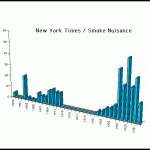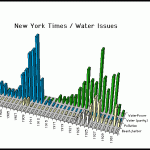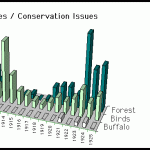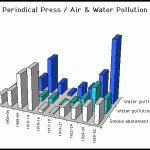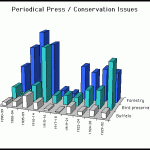The confluence of newspapers and the environment in the early 20th century
Paper to the Association for Education in Journalism and Mass Communications
Science Writers Education Group (Sciphers)
Baltimore, MD, August, 1998
Edited for the Web December, 1999
Bill Kovarik Ph.D.
Abstract: A quantitative examination of news coverage of selected public health and conservation issues in the 1899 – 1932 period shows a striking bipolar distribution, indicating a revival of Progressive era concerns late in the 1920s and the ubiquity of environmental controversy. More research is recommended in this relatively unexplored area.
———————-
Introduction
Environmental concerns have surfaced repeatedly in the American news media since its early days. This would only seem logical — after all, the problems would have certainly been apparent — but it is a relatively new perspective for historians.
In our recent book, Mass Media and Environmental Conflict, (1) Mark Neuzil and I pointed this out and took issue with the “traditional error” that environmental conflict emerged in the late 20th century in an “historical void.”(2) Historians have erroneously held that the development of science and technology was “largely unquestioned” until the late 20th century, (3) and that we could trace the beginning of environmental controversy to Rachel Carson’s 1962 book, Silent Spring, (4) or to the first 1970 celebration of Earth Day. (5)
This perspective simply reflects a lack of research. Our research has shown a good deal of news coverage of animal extinctions, conservation and public health issues long before the modern period. In fact, as we finished Mass Media and Environmental Conflict, Dr. Neuzil and I began to feel we had only begun to scratch the surface. It’s an exciting feeling to have come across an unexplored intellectual frontier of this magnitude.
It’s possible to identify many hundreds or thousands environmental conflicts in the 18th, 19th and early 20th centuries, and most of them are centered around concerns about public health and conservation. The Progressive Era, especially, is known as a time of awakening concern. It was a time when the news media was emerging from parochialism into a broader national perspective; when science and technology were having visible impacts on daily life; and when the emerging Progressive movement found a willing if sometimes unreliable ally in the news media.
To consider the confluence of journalism history and environmental history in this time period, we can take any number of historical approaches. An preliminary bibliographic sketch (attached) shows about 20 dissertations, theses, articles and books examined journalism history and the environment. Much of the early work was oriented towards biography and institutional studies. By the 1980s the contextual history movement in other areas had affected journalism history as well, and we started seeing broader approaches and diachronic studies of specific incidents. One would have hoped to find that journalism history also began adding to the record of environmental history; however, even though the historical record is rich and unexplored, we haven’t begun to see that potential realized.
There is still a great deal of work to be done in tracing specific controversies. We know very little about the role of the press in the movements for wildlife preservation, milk pasteurization, water purification and regulation of new technologies.
Also, we have only a few glimpses of how journalists interacted with organizations like the National Coast Anti Pollution League, the Audubon Society, the Isaac Walton League, the National Consumers League. Was it a broad alliance, part of the world view of journalism at the time? Or were there only sporadic and strategic agreements? In the introduction to Mitchell Stephens book, A History of News, Stephens notes that in 1955, one editorialist suggested newspapers “should outgrow the phase of knight-errantry.” Uplift and persuasion were more important goals for journalists of the Progressive era, he says, than those of later generations. The persistence and ubiquity of public health and conservation issues seems to bear this out. Yet in some of the specific Progressive era controversies, for example the Hearst crusade over impure water used to make ice, only the most sensationalistic papers seem willing to take on public health or environmental crusades. Why this is so — and what impact that may have had on our understanding of the history of the environment — is an interesting and open question.
Another question is the extent to which the emotionalism of the modern environmental movement was reflected in the news media of the Progressive era. It’s interesting to find articles about buffalo extinction labeled “The Crime of the Century” and the extinction of birds to adorn women’s hats labeled “Millinery Murder.” It’s also interesting to see editorial cartoons about air pollution and city sanitation, such as those in the New York World.
Thus, journalists were in fact covering environmental issues, but how do we judge the extent of the coverage? Here we take a quantitative approach and sketch an overview of the cycles of public health and environmental controversy in the Progressive era.
Looking at the New York Times index for the years 1899 to 1926, we can can simply count the number of news articles and see the rising news coverage of water pollution, air pollution and conservation issues such as bird protection and forestry. As a point of comparison, we may also look at the Readers Guide to Periodical Literature (magazines) in the same categories.
In the early years, a quantifiable shift in public priorities is evident in the general number of news articles and some of the specific approaches. For example, as late as 1905, the New York Times ran a somewhat maudlin article about the joys of a buffalo hunt. Only two years later, we find six items on the extinction of buffalo and attempts to preserve remaining herds. And in 1908, then-President Theodore refused to re-live his youthful buffalo hunting experiences specifically because buffalo were becoming extinct, according to the Times.
The striking thing about the general pattern of news coverage is the bipolar distribution of coverage and the similarity between the patterns of coverage in the Times and in the periodical press. Apparently, a strong revival of environmental concerns took place in the late 1920s. And yet, many histories of the Progressive era, for example those by Samuel Hayes and Carolyn Merchant, stop around World War I. (See bibliography below). One possible explanation for this revival is that environmental concerns had become less of a matter of public controversy and more deeply institutionalized by government.
In Chart I, we see New York Times coverage of air pollution or the “smoke nuisance” controversy has a very clear bipolar distribution. Interestingly, between 1905 and 1907, the Times used the term “air pollution,” and returned permanently to that label in 1933. In the interim, however, the term “smoke nuisance” or “smoke abatement” was preferred. This shows the need to be aware of the specific terminology of the era in order to uncover these controversies.
Chart II shows the New York Times coverage of water pollution issues. Again, there is quite a bit of crossover in terms of labeling. “Water pollution” as a category is found in 1907 and 1908, but the general category of “water” also focused heavily on purification of drinking water and the problem of cleaning up sewers. A dramatic increase in concern about water power began around World War I, while the category of “water pollution” returned in the late 1920s. “Beach pollution” was also a serious concern around this time, as was “oil — harbor pollution.” The articles correspond with the emergence of the National Coast Anti-Pollution League and attempts to legislate an end to oil dumping at sea — a controversy that continued through the 1920s.
The same bipolar trends hold true in Chart III, where we see New York Times coverage of forestry and bird preservation rising with the Progressive movement and falling off as war approaches. And again, we see a second wave of Progressive concerns in the 1920s. Chart IV and Chart V show a very similar trend in the Readers Guide to Periodical Literature.
These charts are preliminary and they don’t cover many of the other environmental and public health controversies of the Progressive era. They do conform to what we might expect about the submersion of domestic concerns in a time of international warfare between 1915 and 1919, but they also raise many questions about the prevalence of environmental concerns in the late 1920s. Is there an “institionalization” factor, as mentioned above? Is the coverage emerging as a result of a new-found appreciation for the benefits and dangers of science? Or are there other factors?
Government initiatives certainly explain some of the patterns. Forestry is a good example that has been well examined by Steven Ponder, who wrote about the US Forest Service’s unprecedented publicity drive in this period. Ponder found that the Forest Service published 10.8 million copies of advisories, pamphlets, bulletins and reports in the 1898 to 1910 era. The service was so active in promoting itself that it came in for sharp attacks by a number of US senators around 1909, and we see a decline in forestry related articles after 1910. What accounts for the strong revival of interest in forestry in the 1923 – 1925 period is an open question.
A similar peak in news coverage emergse around legislative hearings and proposals for bird preservation. Before 1912, millions of birds were slaughtered each year for their feathers, which were used to adorn women’s hats. The controversy was sparked by warnings from the Audubon Society and Isaac Walton League that egrets, herons, flamingos and other tropical birds were in danger of extinction. A law passed in 1912 protected migratory and tropical birds, and subsequent laws prevented their importation.
These are only a few of the conservation and public health issues covered by the press in the early 20th century, but they are indicative of a very large and relatively unexplored area in the history of journalism and of the environment. Given modern concerns about public health, conservation and other environmental issues, it is surprising that so little of this history is understood today.
Spanish writer Miguel de Cervantes once said that experience is the mother of knowledge. Recent trends in historical writing would seem to bear him out. Knowledge of African-American history was animated by the experience of the civil rights movement of the 1960s; women’s history came alive with the feminist movement of the 1970s; and the history of Native Americans took on a more serious cast with the 500th anniversary of Columbus’ arrival in the New World in 1992. Similarly, modern concerns about public health and the environment are generating scholarly inquiry about history of technology, science and the environment. This is not to say that the agenda for historical research is driven solely by modern concerns, but that they can be an appropriate factor.
Another factor has been a recognition that histories of wars, politics, great men and great institutions have been overemphasized to the detriment of other interesting and valid perspectives. The recognition has given rise to various schools of social, cultural and intellectual history since the 1960s. Environmental history, history of science and history of technology have been among them.
In a similar vein, a handful of journalism historians have examined the confluence of newspapers and the environment in history, as seen in the attached bibliography, but a great deal remains to be explored.
———————–
Journalism history and the environment: a preliminary bibliography
Institutional and biographical
Barrett Fine, A Giant of the Press: Carr Van Anda, Oakland, Calif.: Acme Books, 1968).
Estes, D. C. “The Rival Sporting Weeklies of William T. Porter and Thomas Bangs Thorpe. American Journalism. 2: 135-143, 1985.
Kates, J. 1995. “The Conservationist as Journalist: P.S. Lovejoy and the Fight for the Cutover,” American Journalism. 12:2 (Spring): 123-141, 1995.
Bill Kovarik, “Dr. North and the Kansas City Milk War;” Paper presented to AEJMC conference, Washington, D.C., August 1989;
Gail R. Meadows, “Scientific American: A Mirror of Scientific Progress, 1845-1968,” Master’s Thesis, University of Missouri, 1969.
John Palen, “Science and Walter Lippmann,” Master’s Thesis, University of Michigan, 1984.
David J. Rhees, “A New Voice for Science: Science Service Under Edward Slosson, 1921-29,” Master’s Thesis, University of North Carolina, 1979.
Volkmer, Richard M., “Edward Livingston Youmans and the Popular Science Monthly: A Study in 19th Century American Science-Technology Journalism,” Master’s Thesis, Iowa State University, 1969.
Sally A. Harris-Wheeler, “The Ladies Home Journal Between 1890 and 1906: The Influence of its Crusade to Regulate Food and Drug Products;” ;” Paper presented to AEJMC conference, Washington, D.C., August 1989.
Contextual
Nola Kay Gibson, “A History of Medical Journals in the United States,” Master’s thesis, University of Missouri, 1983.
Carolyn D. Hay, “A History of Science Writing in the United States and of the National Association of Science Writers, Inc.,” Master’s Thesis, Northwestern University, 1970.
Marcel LaFollette, “Authority, Promise and Expectation: The Images of Science and Scientists in American Popular Magazines,” 1910-1955, Ph.D. Dissertation, Indiana University, 1979.
C.L. LaMay and E. E. Dennis. Media and the Environment. Washington: Island Press, 1992.
Genevieve Gardner McBride, “No Season of Silence: Uses of Public Relations in 19th and Early 20th Century Reform Movements in Wisconsin, Ph.D. Dissertation, University of Wisconsin, 1989.
Mark Neuzil and Bill Kovarik, Mass Media and Environmental Conflict, New York.: Sage, 1996.
Phil Shabecoff, A Fierce Green Fire: The American Environmental Movement. Hill & Wang, 1993.
Harry H. Stein, “American Muckraking of Technology Since 1900,” Journalism Quarterly 67, Vol. 2 (Summer 1990), p. 401.
Diachronic / Specific Events & Trends
Bill Kovarik, “Agenda Setting in the 1924-1926 Public Health Controversy over Ethyl (Leaded) Gasoline,” Paper presented to the Association for Education in Journalism and Mass Communication, Reno, Nevada. April, 1994
Bill Kovarik, “The Ethyl Controversy,” Ph.D. dissertation, University of Maryland, 1993.
Calder M. Pickett, “Six New York Newspapers and their Response to Technology in the 19th Century,” Ph.D. Dissertation, University of Minnesota, 1959. Also, see Idem, “Technology and the New York Press in the 19th Century,” Journalism Quarterly, 37: 398-407, Summer 1960.
Steve Ponder, “‘Nonpublicity’ and the Unmaking of a President: William Howard Taft and the Ballinger-Pinchot Controversy of 1909-1910,” Journalism History 19:4. (Winter): 111-120, 1994.
Steve Ponder, “Federal News Management in the Progressive Era: Gifford Pinchot and the Conservation Crusade,” Journalism History 13:2 (Summer): 42-48, 1986.
Steve Ponder, “Conservation, Community Economics and Newspapering: The Seattle Press and the Forest Reserve Controversy of 1897,” American Journalism 1: 50-60, 1986.
Steve Ponder, “The Progressive Drive to Shape Public Opinion 1898-1913,” Public Relations Review, Vol. 16, No. 3, Fall 1990.

